Case Studies
Case Studies
- Construction of A New Organic-inorganic Composite Emulsion and Its Enhanced Mechanical Properties of Oil Well Cement(Part 1)
- Construction of A New Organic-inorganic Composite Emulsion and Its Enhanced Mechanical Properties of Oil Well Cement(Part 2)
- The Application Prospects of DeepSeek Large Model in Petroleum Engineering(Part 1)
- The Application Prospects of DeepSeek Large Model in Petroleum Engineering(Part 2)
- Development and Performance Evaluation of Efficient Asphalt Dispersant (Part 1)
- Development and Performance Evaluation of Efficient Asphalt Dispersant (Part 2)
- Development and Performance Evaluation of Efficient Asphalt Dispersant (Part 3)
- Research and Application Status of Drilling Fluid Plugging Materials (Part 1)
- Research and Application Status of Drilling Fluid Plugging Materials (Part 2)
- Research and Application Status of Drilling Fluid Plugging Materials (Part 3)
2.3 GPC of Retarder HFB-2
According to document reports, the average molecular weight of polymer retarders is about 103~104, demonstrating excellent retarder properties. Table 3 shows the chromatographic analysis results of retarder HFB-2. According to Table 3, the number-average molecular weight Mn and weight-average molecular weight Mw are 1.3×104g•mol-1 and 4.7×104g•mol-1, respectively, indicating relatively low molecular weights. In addition, the polydispersity index (PDI) of the retarder HFB-2 is 3.6, which is a typical free radical polymerization reaction. The above results indicate that the polymer type retarder HFB-2 should theoretically have excellent retarding effect.
.png)
2.4 Thermal Stability Analysis of Retarder HFB-2
The experimental results of the thermal stability analysis of retarder HFB-2 are shown in Figure 2. As shown in Figure 2, the first thermogravimetric region of the retarder HFB-2 is located between 30~260℃, which is mainly responsible for the volatilization of free water in the test sample; The second thermogravimetric region is located between 260~350℃, which is mainly the thermal decomposition of molecular side chains in the retarder HFB-2, such as sulfonic acid groups and amide groups; The third thermogravimetric region is located between 350~460℃, which is mainly responsible for the breaking and decomposition of the molecular main chains in the retarder HFB-2; The fourth decomposition zone is located between 460~800℃, which is mainly responsible for the thermal decomposition of the rigid cyclic structure contained in the maleic anhydride in the retarder HFB-2. The results of thermogravimetric analysis show that the starting temperature of thermal decomposition of retarder HFB-2 is about 260℃, indicating that retarder HFB-2 has excellent thermal stability and can be applied to complex well cementing operations such as deep wells, ultra deep wells, and geothermal wells.

2.5 Performance Evaluation of Retarder HFB-2
(1) Thickening Time of Cement Slurry
Prepare blank cement slurry and cement slurry with added retarder HFB-2 in accordance with SY/T 5504-2013, and their composition is shown in Table 4. The main components of cement slurry include oil well cement, fluid loss agent, dispersant, and slurry water. The effect of retarder HFB-2 on the thickening time of cement slurry at different temperatures and dosages was investigated based on different cement slurry compositions. The experimental results are shown in Table 5. Compared with blank cement slurry 1 #, the addition of retarder HFB-2 significantly increases the thickening time of the cement slurry system. If the dosage of cementing retarder HFB-2 is added, the thickening time of cement slurry decreases with increasing temperature; If the experimental temperature is fixed, the thickening time of cement slurry increases with the increase of the dosage of retarder HFB-2. When the dosage of retarder HFB-2 is 1.2% (2 # cement slurry system), the experimental temperature is increased from 200℃ to 220℃, and the thickening time of the cement slurry is reduced from 348 minutes to 312 minutes. In addition, when the reaction temperature is 220℃, the thickening time of the cement slurry increases from 312 minutes to 326 minutes when the dosage of the retarder is increased from 1.2% to 1.5%. This indicates that adjusting the dosage of retarder HFB-2 can effectively control the thickening time of cement slurry to meet the requirements of different construction conditions. At the same time, the right angle thickening effect of the cement slurry system is good, with a right angle thickening time of less than 30 minutes and an initial viscosity of less than 20 Bc. The thickening performance of the cement slurry system is good, without any adverse thickening linearity such as bulging and steps. In addition, the performance of the retarder HFB-2 prepared in this article was compared with other products, and the results are shown in Table 6. According to Table 6, compared to other products, the high-temperature resistant zwitterionic retarder HFB-2 prepared by our research institute has advantages such as small dosage, good temperature resistance, and simple synthesis process.
.png)
.png)

(2) Rheological Properties of Cement Slurry
The effect of the dosage of retarder HFB-2 on the rheological properties of cement slurry is shown in Table 7. After the cement slurry is prepared, it is first placed in a 90 ℃ atmospheric pressure thickener to thicken for 20 minutes. Then, a six speed rotary viscometer is used to test the dial readings at different speeds, and the fluidity index n and consistency coefficient K of the cement slurry are calculated. The results showed that as the dosage of retarder HFB-2 gradually increased, the reading of the six speed rotational viscometer during the rheological performance testing of cement slurry continuously decreased, the flowability index n of cement slurry increased, and the viscosity coefficient K rapidly decreased, indicating that retarder HFB-2 has a significant dispersion effect.

(3) Compressive Strength of Cement Stone
The effect of the dosage of retarder HFB-2 on the compressive strength of cement stone is shown in Figure 3. Through analysis, it can be concluded that the compressive strength of each cement slurry system is greater than the 14 MPa corresponding to the 24 hour curing age specified in the standard SY/T 5504.1-2013. Meanwhile, the addition of retarder HFB-2 has a certain delaying effect on the development of compressive strength of cement stone, and this delaying effect becomes more pronounced with the increase of retarder HFB-2 dosage. However, as the curing age increases, the difference in compressive strength of cement stone with three different dosages of retarder HFB-2 gradually decreases, indicating that retarder HFB-2 will not have a negative impact on the long-term compressive strength development of cement stone.
.png)
2.6 Delaying Mechanism of HFB-2 Retarder
(1) Phase Analysis of Cement Slurry Hydration Products
In order to further explore the retarding mechanism of retarder HFB-2, X-ray diffraction analysis was conducted on the hydration products of cement slurry samples 1 # and 2 # after 24 hours of hydration. The experimental results are shown in Figure 4. The results show that there is no significant difference between the types of hydration products of 1 # and 2 # cement slurries, including the unhydrated mineral components of tricalcium silicate (C3S) and dicalcium silicate (C2S), as well as the hydrated calcium silicate gel (C-S-H), calcium hydroxide and ettringite (AFt). The difference lies in the fact that the retarder HFB-2 causes a significant change in the intensity of diffraction peaks of certain products, such as the C-S-H and Ca (OH) 2 diffraction peaks, which are significantly weakened, while the AFt diffraction peak intensity is weakened to a lesser extent. This indicates that the retarder HFB-2 exerts a retarding effect by delaying the reaction rate of C-S-H and Ca (OH) 2 generation.

(2) Morphological Analysis of Cement Slurry Hydration Products
In order to further explore the retarding mechanism of retarder HFB-2, the hydration products of cement slurry samples 1 # and 2 # after 24 hours of hydration were analyzed by scanning electron microscopy. The experimental results are shown in Figure 5. The results indicate that the hydration products of cement slurries 1 # and 2 # after 24 hours of hydration both contain some unhydrated cement particles. There are many columnar and clustered C-S-H, as well as partially layered Ca (OH) 2 crystals in the hydration products of cement slurry. Compared with 1 # cement slurry, the content of C-S-H and Ca (OH) 2 crystals in the hydration products of 2 # cement slurry is significantly reduced, and more unhydrated cement particles appear. This is because the long-chain structure of polymer type retarder HFB-2 can adsorb on the surface of cement particles and exert water film protection through spatial hindrance, thereby blocking the contact between cement particles and free water, inhibiting the growth of hydration product crystal nuclei, and delaying the hydration reaction of oil well cement. In addition, the oxygen atoms in the sulfonic acid and carboxylic acid groups have a strong coordination effect, occupying the normal growth sites of Ca (OH) 2 crystals after adsorption or chelation with Ca2+ in the solution, inhibiting the normal growth and development of Ca (OH) 2 crystals, preventing the formation of precipitates, and thus reducing the hydration rate of cement.

3. Conclusion
This article combines molecular structure design ideas and functional monomer optimization methods to synthesize a high-temperature resistant zwitterionic polymer type oil well cement retarder HFB-2 through aqueous solution polymerization. The results showed that the optimal preparation process conditions for the retarder HFB-2 were m (AM): m (AMPS): m (MAH): m (DMDAAC)=8:10:6:8, initiator dosage of 1.2%, reaction time of 3.5 hours, reaction temperature of 80℃, monomer concentration of 34%, and dripping time of maleic anhydride monomer solution of 30 minutes. The data of infrared spectrum analysis, gel chromatography analysis and thermogravimetric analysis showed that the molecular structure of the retarder HFB-2 was in line with the expected design. The weight average molecular weight and number average molecular weight were 1.3x104 g•mol-1 and 4.7x104 g•mol-1, respectively, with good thermal stability. The retarder HFB-2 can effectively improve the thickening time of cement slurry under high temperature conditions, and has no negative impact on the long-term compressive strength development of cement slurry. The retarder HFB-2 has good high temperature retarding characteristics, and the retarding mechanism is reflected in the inhibition of the formation of calcium silicate hydrate gel Ca (OH) 2 crystal through adsorption and complexation.



